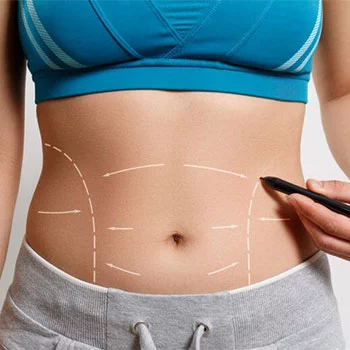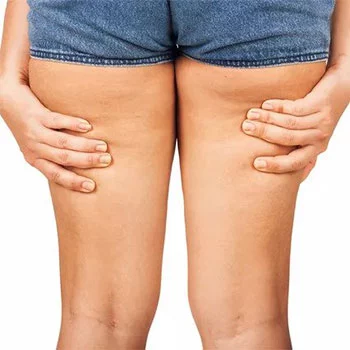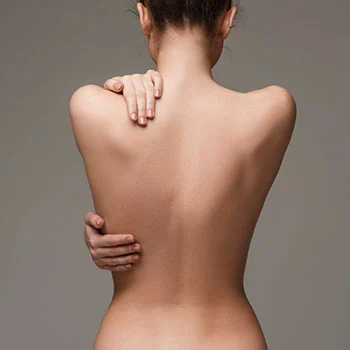What is panniculectomy?
A panniculectomy is a surgical procedure that focuses on removing excess skin and tissue from the lower abdomen, specifically targeting the pannus or apron of skin that hangs over the pubic area. This procedure is primarily performed to alleviate medical issues caused by the overhanging skin rather than for cosmetic reasons.
Panniculectomy is often recommended for individuals who have a significant amount of excess skin in the lower abdominal area, typically resulting from massive weight loss, pregnancy, or other factors. The surgery aims to address functional problems associated with the excess skin, such as skin irritation, infections, hygiene issues, and mobility limitations. Unlike abdominoplasty, which may involve muscle repair and cosmetic contouring of the abdomen, panniculectomy primarily focuses on removing the overhanging skin to improve the patient's quality of life and alleviate physical discomfort caused by the excess tissue.
Why is panniculectomy done?
Panniculectomy is performed to address medical issues and functional problems associated with excess skin and tissue in the lower abdominal area, specifically targeting the pannus or apron of skin that hangs over the pubic region. This procedure is done for the following reasons:
- Skin irritation: Excess skin in the lower abdomen can lead to skin irritation, redness, chafing, and rashes due to friction and moisture buildup, causing discomfort and potential skin infections.
- Hygiene issues: The overhanging skin can make it challenging to maintain proper hygiene, leading to difficulties in cleaning and drying the skin folds, which may predispose individuals to bacterial or fungal infections.
- Infections: Panniculus, the fold of excess skin, can trap moisture and bacteria, increasing the risk of skin infections such as cellulitis, folliculitis, or intertrigo, which can be recurrent and require medical treatment.
- Mobility restrictions: The weight and size of the pannus can restrict movement, cause difficulty in performing daily activities, and contribute to musculoskeletal issues, affecting mobility and quality of life.
- Psychological impact: Individuals with a large overhanging pannus may experience emotional distress, body image concerns, and low self-esteem due to the physical appearance and functional limitations associated with the excess skin.
By addressing these medical issues and functional challenges through panniculectomy, patients can experience relief from physical discomfort, improve their quality of life, enhance mobility, reduce the risk of skin problems, and boost self-confidence. Panniculectomy is considered a beneficial surgical intervention for individuals struggling with the health consequences of excess lower abdominal skin and tissue, providing both physical and emotional benefits.
Panniculectomy vs. tummy tuck: what’s the difference?
Both panniculectomy and abdominoplasty (tummy tuck) are surgical procedures on the abdominal area, but they serve different purposes and target distinct concerns based on medical necessity and cosmetic goals. Here are the key differences between panniculectomy and abdominoplasty:
Purpose
Panniculectomy primarily focuses on removing excess skin and tissue in the lower abdomen, specifically targeting the pannus or overhanging apron of skin to address medical issues and functional problems caused by the excess skin.
Abdominoplasty is a cosmetic procedure that involves removing excess skin and fat, tightening abdominal muscles, and reshaping the abdomen to improve aesthetic appearance and contour.
Medical necessity
Panniculectomy is often considered medically necessary when excess skin leads to health concerns such as skin irritation, infections, hygiene issues, and mobility restrictions.
Abdominoplasty is generally performed for cosmetic reasons to enhance the appearance of the abdomen, although functional benefits may also be achieved.
Extent of surgery
Panniculectomy mainly focuses on excess skin and tissue removal, with less emphasis on muscle repair or cosmetic contouring.
Abdominoplasty involves removing excess skin and fat, tightening abdominal muscles, and reshaping the abdomen for aesthetic purposes, resulting in a flatter and more toned appearance.
Insurance coverage
Panniculectomy may be covered by insurance if deemed medically necessary due to documented health issues caused by the excess skin.
Tummy tuck is generally not covered by insurance as it is considered a cosmetic procedure.
Scarring
Panniculectomy results in a scar along the lower abdomen where the excess skin is removed.
Abdominoplasty involves scarring, typically low on the abdomen and around the belly button, but may vary based on the surgical technique used.
Who is a suitable candidate for panniculectomy?
Ideal candidates for panniculectomy are individuals who have a significant amount of excess skin and tissue in the lower abdominal area, leading to medical issues and functional problems. The following criteria may indicate suitability for panniculectomy:
- Excess skin: Candidates should have a large pannus or overhanging apron of skin in the lower abdomen, often resulting from massive weight loss, pregnancy, or other factors, causing physical discomfort and functional limitations.
- Medical issues: Individuals experiencing skin irritation, infections, hygiene problems, mobility restrictions, or other health concerns directly related to the excess skin may benefit from panniculectomy to alleviate these issues.
- Stable weight: Candidates should have maintained a stable weight for a significant period, as fluctuations in weight can affect the outcomes of the surgery and potentially lead to a recurrence of excess skin.
- Good health: Generally, candidates for panniculectomy should be in good overall health with no uncontrolled medical conditions that could increase surgical risks or impair healing.
- Realistic expectations: Candidates should have realistic expectations about the outcomes of panniculectomy and understand that the procedure is primarily aimed at addressing medical issues rather than providing purely cosmetic benefits.
- Commitment to recovery: Candidates should be willing to follow postoperative care instructions, including proper wound care, wearing compression garments, attending follow-up appointments, and adopting a healthy lifestyle to support optimal healing and long-term results.
- Non-smoker: Smoking can impair healing and increase the risk of complications after surgery. Ideal candidates for panniculectomy are typically non-smokers or willing to quit smoking before and after the procedure to promote successful outcomes.
Before undergoing panniculectomy, individuals should consult with a board-certified plastic surgeon or a qualified healthcare provider experienced in body contouring surgeries to assess their candidacy, discuss treatment options, and receive personalized recommendations based on their unique needs and goals. By meeting the criteria for ideal candidates, individuals can maximize the benefits of panniculectomy and achieve improved physical comfort, functionality, and quality of life.
How do I prepare for panniculectomy?
Preparing for a panniculectomy involves several important steps to ensure a successful surgery and smooth recovery. Here are some key ways to prepare for a panniculectomy:
- Consultation: Schedule a consultation with a board-certified plastic surgeon who specializes in body contouring procedures. During the consultation, discuss your medical history, expectations, and goals for the surgery.
- Medical evaluation: Undergo a thorough medical evaluation to assess your overall health and identify any underlying medical conditions that may affect the surgery or recovery process.
- Quit smoking: If you smoke, it is advisable to quit smoking several weeks before surgery, as smoking can impair healing and increase the risk of complications.
- Maintain a stable weight: Aim to maintain a stable weight before surgery to optimize results and reduce the risk of complications. Your surgeon may recommend reaching a healthy weight range if necessary.
- Follow preoperative instructions: Your surgeon will provide specific preoperative instructions, which may include guidelines on medications to avoid, fasting before surgery, and any necessary preoperative tests.
- Arrange for help: Plan for someone to drive you to and from the surgical facility on the day of the procedure and assist you during the initial days of recovery.
- Prepare your home: Create a comfortable recovery space at home with necessary supplies such as loose and comfortable clothing, pillows for support, and any prescribed medications.
- Postoperative care: Familiarize yourself with postoperative care instructions provided by your surgeon, including wound care, activity restrictions, and follow-up appointments.
- Nutrition and hydration: Maintain a healthy diet rich in nutrients to support healing and recovery. Stay hydrated before and after surgery.
- Ask questions: Do not hesitate to ask your surgeon any questions or express any concerns you may have about the procedure, recovery, or expected outcomes.
By following these preparation tips and working closely with your surgeon, you can help ensure a successful panniculectomy procedure and a smooth recovery process.
What to expect during a panniculectomy
During a panniculectomy, which is a surgical procedure to remove excess skin and tissue in the lower abdominal area, several key steps and aspects can be expected. Here is an overview of what to expect during a panniculectomy:
- Anesthesia: Before the surgery begins, you will be administered anesthesia to ensure you are comfortable and pain-free during the procedure. The type of anesthesia used (general or local anesthesia) will be determined by your surgeon based on your individual needs and the extent of the surgery.
- Incisions: The surgeon will make incisions in the lower abdominal area, typically below the belly button, to access and remove the excess skin and tissue. The incisions are strategically placed to minimize visible scarring and achieve optimal results.
- Skin and tissue removal: The surgeon will carefully remove the excess skin and tissue, focusing on the pannus or overhanging apron of skin that causes functional issues such as skin irritation, infections, and mobility restrictions.
- Muscle repair (if needed): In some cases, the surgeon may repair weakened or separated abdominal muscles during the procedure to improve abdominal wall strength and contour.
- Wound closure: Once the excess skin and tissue have been removed and any muscle repair completed, the surgeon will close the incisions using sutures or other closure techniques. Drains may be placed to prevent fluid buildup and aid in healing.
- Recovery and monitoring: After the surgery, you will be monitored in the recovery room to ensure your vital signs are stable, and you are waking up from anesthesia safely. You may experience some discomfort, swelling, and bruising, which are normal after surgery.
- Hospital stay: Depending on the extent of the surgery and your overall health, you may require a short hospital stay for monitoring and initial recovery. In some cases, panniculectomy can be performed on an outpatient basis.
- Postoperative care: Your surgeon will provide detailed instructions on postoperative care, including wound care, activity restrictions, pain management, and follow-up appointments. It is essential to follow these instructions diligently to promote proper healing and optimal results.
- Results: Over time, as swelling subsides and the incisions heal, you will begin to see the results of the panniculectomy, with improved abdominal contour, reduced skin overhang, and relief from functional issues caused by the excess skin.
By understanding what to expect during a panniculectomy and following your surgeon's guidance before and after the procedure, you can prepare yourself for a smoother recovery and achieve the desired outcomes of the surgery.
What to expect after surgery
After undergoing a panniculectomy, it is important to be aware of what to expect during the recovery period. Here are some common aspects and considerations for the recovery phase after a panniculectomy:
- Pain and discomfort: It is normal to experience some pain, discomfort, swelling, and bruising in the treated area following surgery. Your surgeon may prescribe pain medications to help manage any postoperative discomfort.
- Drains and dressings: If drains were placed during the surgery to prevent fluid buildup, you will need to empty and measure the drainage regularly as instructed by your surgeon. Dressings over the incision sites should be kept clean and dry according to postoperative care guidelines.
- Activity restrictions: Your surgeon will provide specific instructions regarding activity restrictions, including limitations on lifting, bending, and strenuous activities. It is crucial to follow these guidelines to avoid complications and promote proper healing.
- Wound care: Proper wound care is essential for optimal healing and to minimize the risk of infection. Follow your surgeon's instructions on how to care for your incisions, including cleaning, dressing changes, and signs of infection to watch for.
- Swelling and bruising: Swelling and bruising are common after surgery and will gradually improve over time. Elevating your legs and using cold compresses as recommended can help reduce swelling and discomfort.
- Follow-up appointments: Attend all scheduled follow-up appointments with your surgeon to monitor your healing progress, remove sutures or drains if needed, and address any concerns or questions you may have.
- Compression garments: Your surgeon may recommend wearing compression garments to support the treated area, reduce swelling, and help shape the contours of your abdomen during the recovery period.
- Nutrition and hydration: Maintain a healthy diet rich in nutrients to support healing and recovery. Stay hydrated by drinking plenty of water and avoiding excessive salt intake, which can contribute to swelling.
- Physical activity: Gradually reintroduce light physical activity as advised by your surgeon. Avoid strenuous exercise and heavy lifting until you receive clearance to do so.
- Emotional support: Recovery from surgery can be physically and emotionally challenging. Seek support from family, friends, or a healthcare professional if you experience any emotional distress during the recovery process.
By being informed about what to expect after surgery and following your surgeon's postoperative instructions diligently, you can promote a smooth recovery, minimize complications, and achieve the best possible outcomes from your panniculectomy procedure.
Risks and complications
While panniculectomy is generally considered a safe procedure, like any surgical intervention, it carries certain risks and potential complications. It is important to be aware of these risks before undergoing surgery. Here are some common risks and complications associated with panniculectomy:
- Bleeding: Excessive bleeding during or after surgery can occur, leading to complications that may require additional treatment or surgical intervention.
- Infection: Infections at the incision sites are a potential risk following surgery. Proper wound care and adherence to postoperative instructions can help reduce the risk of infection.
- Poor wound healing: Some patients may experience delayed wound healing, wound separation, or wound breakdown, particularly in areas with reduced blood supply.
- Scarring: While surgeons make every effort to minimize scarring, some degree of scarring is inevitable after a panniculectomy. Scars may be visible and could require additional treatments to improve their appearance.
- Changes in sensation: Temporary or permanent changes in sensation, such as numbness or hypersensitivity, may occur in the treated area or surrounding skin.
- Fluid accumulation (seroma or hematoma): Fluid buildup under the skin (seroma) or blood collection (hematoma) can occur after surgery, requiring drainage or aspiration.
- Deep vein thrombosis (DVT): Prolonged immobility after surgery can increase the risk of developing blood clots in the legs (DVT), which can be a serious and potentially life-threatening complication.
- Pulmonary complications: In rare cases, pulmonary complications such as pneumonia or atelectasis (partial lung collapse) may occur, particularly in patients with underlying respiratory conditions.
- Anesthesia risks: Adverse reactions to anesthesia, though rare, can include respiratory problems, allergic reactions, and cardiovascular complications.
- Unsatisfactory results: Despite the surgeon's best efforts, there is a possibility of unsatisfactory aesthetic outcomes or asymmetry that may require revision surgery.
It is essential to discuss these risks and potential complications with your surgeon during the consultation process. Your surgeon will assess your individual risk factors, provide personalized recommendations, and take steps to minimize the likelihood of complications during and after surgery. By understanding the potential risks and complications associated with panniculectomy, you can make an informed decision about undergoing the procedure and take an active role in your postoperative care and recovery.
Panniculectomy cost and insurance coverage
The cost of a panniculectomy can vary depending on various factors such as the geographic location, the surgeon's experience, the extent of the procedure, the surgical facility fees, anesthesia fees, pre-operative tests, post-operative care, and any additional services required. On average, the cost of a panniculectomy in the United States ranges from $8,000 to $15,000 or more.
It is important to note that panniculectomy is a surgical procedure that is sometimes considered medically necessary to address health issues caused by excess skin and tissue in the lower abdominal area. In some cases, insurance may cover the cost of panniculectomy if it is deemed medically necessary. However, insurance coverage criteria can vary, and pre-authorization may be required.
Before undergoing a panniculectomy, it is recommended to consult with a board-certified plastic surgeon to discuss your individual needs, goals, and the associated costs. The surgeon can provide a personalized treatment plan, including a cost estimate, and discuss payment options or financing plans if needed.
Additionally, it is essential to inquire about what the cost of panniculectomy includes, such as pre-operative consultations, surgical procedures, anesthesia, post-operative care, follow-up visits, and any potential revision surgeries. Understanding the full cost breakdown and any potential additional fees can help you plan for the financial aspect of undergoing a panniculectomy procedure.
FAQs
How long does a panniculectomy surgery take?
The duration of a panniculectomy surgery can vary depending on the complexity of the procedure, the amount of excess skin and tissue to be removed, and whether additional treatments like muscle repair are needed. On average, panniculectomy surgery can take 2 to 4 hours to complete.
Should I have weight loss before panniculectomy?
Before undergoing a panniculectomy, it is generally recommended to reach a stable weight and maintain good overall health. Weight loss before surgery can help optimize results and reduce the risk of complications.
What is the suitable BMI for panniculectomy?
While there is no specific BMI cutoff for panniculectomy, patients with a BMI within a healthy range or slightly overweight may have lower risks and better outcomes. Surgeons evaluate each patient individually to determine suitability for the procedure.
Will panniculectomy leave visible scars?
Panniculectomy will leave scars, but the extent and visibility of the scars can vary depending on factors such as incision placement, skin quality, and individual healing. Surgeons aim to minimize scarring and may provide postoperative scar care instructions.




